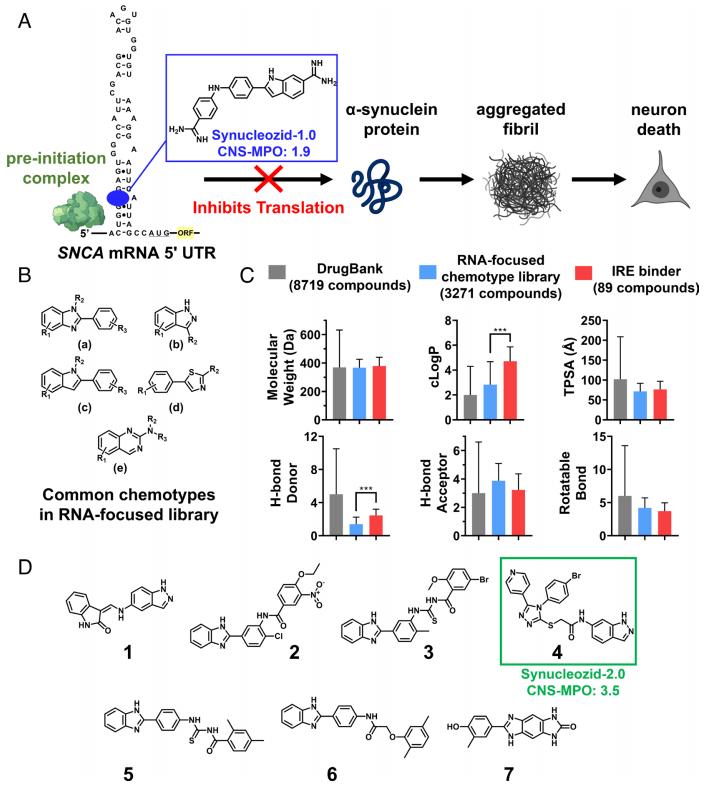α-synuclein is an important drug target for Parkinson's disease therapy, but it is also an intrinsically disordered protein that lacks a typical small molecule binding pocket. In contrast, the SNCA-encoding mRNA has an ordered structural region in its 5′ untranslated region (UTR). Recently, a research report titled "Decreasing the intrinsically disordered protein α-synuclein levels by targeting its structured mRNA with a ribonuclease-targeting chimera" was published in the international journal Proceedings of the National Academy of Sciences. Scientists from The Scripps Research Institute and other institutions have developed a new method to combat α-synuclein by targeting the mRNA that forms α-synuclein. This platform can be used to expand druggability of many challenging disease targets.
View all Premade mRNA Products

Figure 1. Schematic depiction of α-synuclein-mediated disease pathway shows small molecules targeting the SNCA IRE can inhibit α-synuclein translation. (Tong Y, et al. 2024)
In the article, the researchers introduced Synucleozid-2.0 and Syn-RiboTAC, which are a combination of mRNA binding and degradation that can reduce α-synuclein levels by targeting α-synuclein-encoding mRNA. Neurodegenerative diseases (especially Parkinson's disease) pose great difficulties to the development of clinical therapies due to the difficulty in targeting specific proteins such as α-synuclein, whose levels often decrease with increases as the disease progresses.
Traditional approaches such as antibodies or antisense oligonucleotides are often limited in targeting disordered proteins such as α-synuclein. Because α-synuclein lacks a stable three-dimensional structure, typical small molecule binding sites or pocket structures, which are common targets of drugs and compounds. The researchers showed that an undruggable protein can be modulated by targeting its encoding mRNA and developed a streamlined workflow to define and study these compounds. This approach could be broadly applicable and includes targeting structural elements throughout an mRNA. The demonstration that targeting RNA structural elements near a start codon is effective to modulate biology suggests that such elements may be important general targetable sites.
| Cat.No. | Product Name | Price |
|---|---|---|
| AD00261Z | Human SNCA adenoviral particles | Inquiry |
| AD15206Z | Human SNCA adenoviral particles | Inquiry |
| LV00479Z | Human SNCA lentiviral particles | Inquiry |
| CDCB160259 | Human SNCA ORF clone (NM_000345.3) | Inquiry |
| CDCB166657 | Chicken SNCA ORF Clone (NM_204673) | Inquiry |
| CDCH083946 | Mouse Snca ORF clone (NM_009221.2) | Inquiry |
| CDCR233609 | Mouse Snca ORF Clone(NM_001042451.1) | Inquiry |
| CDFR011467 | Rat Snca cDNA Clone(NM_019169.2) | Inquiry |
| MiUTR1M-11026 | SNCA miRNA 3'UTR clone | Inquiry |
| MiUTR1M-11027 | SNCA miRNA 3'UTR clone | Inquiry |
| MiUTR1R-07587 | SNCA miRNA 3'UTR clone | Inquiry |
| CKMC-026 | Snca Knockout Mouse Embryonic Fibroblast Cells | Inquiry |
Syn-RiboTAC indirectly restored the expression of approximately half of the dysregulated genes in neurons derived from Parkinson's disease patients. The reduction in α-synuclein levels may be possible by allowing the restoration of some of the dysregulated genes that were disrupted by abnormal accumulation. The downstream effects of reduced α-synuclein can also reduce the body's cellular stress, thereby allowing cells to return to normal function and gene expression patterns. The results may be a breakthrough, demonstrating that traditionally undruggable proteins such as α-synuclein can be targeted through mRNA binding. This enables the expansion of the druggability of disease-related proteins through small molecule binders and degraders.
This study demonstrates that small molecules can target human RNA structural elements and exert riboswitch-like control of translation using exogenously delivered small molecules. Furthermore, Synucleozid-2.0 works by pausing ribosome assembly, and the small molecule is a useful chemical tool to better study this process. Additionally, the researchers demonstrated that one way to enhance bioactivity while retaining selectivity for small-molecule RNA targeting is to convert simple RNA conjugates into RiboTAC degraders. Importantly, RiboTACs do not require binding to a functional site with a small molecule with a binding mechanism of action; instead, they can bind to biologically inert sites and induce their degradation by endogenous nucleases.
Since Parkinson's disease currently has no cure, researchers need to develop effective treatments to reduce symptoms of the disease to maintain quality of life. The results of this study show that by using small molecule binders and RiboTAC degraders to target coding mRNA, it is expected to greatly expand the drug potential of protein composition. This strategy may open the door to treatments for a variety of human neurodegenerative diseases.
Reference
Tong Y, et al. Decreasing the intrinsically disordered protein α-synuclein levels by targeting its structured mRNA with a ribonuclease-targeting chimera. Proceedings of the National Academy of Sciences, 2024, 121(2): e2306682120.

